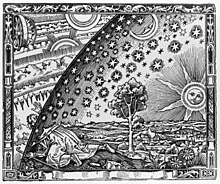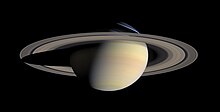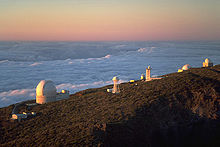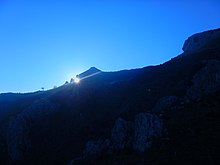astronomy
The Astronomy ( Greek ἀστρονομία for "astronomy", by ἄστρον Astron 'star' and νόμος nómos "Act"), or astronomy is the science of the heavenly bodies . She uses scientific means to research the positions, movements and properties of objects in the universe, i.e. the celestial bodies (planets, moons, asteroids, stars including the sun, star clusters, galaxies and galaxy clusters), interstellar matter and the radiation occurring in space . In addition, she strives for an understanding of the universe as a whole, its formation and structure .
Although astronomy is only a subject in a few schools, its research results are met with a lot of public interest; as an amateur astronomy , it is a widespread hobby. This is due on the one hand to the “uplifting” impression that the starry sky makes even when observed from the open , and on the other hand to its thematic diversity, the touch of philosophical questions and the connection to space travel .
In contrast to earlier times, astronomy as a natural science is now strictly separated from astrology , which tries to infer earthly events from the position and course of the stars. The demarcation is also made because astrology is a pseudoscience - while astronomy studies the nature, movements and relationships of celestial bodies on an empirical basis. Nevertheless, because of the similarity of both names, astrology and astronomy are not infrequently confused by laypeople.
At the universities, astronomy became a separate field of study around 1800, but is now increasingly assigned to physics studies. In German university policy, it is classified as a small subject together with astrophysics .
History of astronomy


Astronomy is considered to be one of the oldest sciences. Its beginnings lie in thinking about the celestial phenomena, in cultic veneration of the stars and in working out a calendar and time determination. In a millennia-long process - particularly well recognizable in the celestial studies of Mesopotamia and Greece - initially astronomy and (“nature”) religion separated, later astronomy and meteorology, in the early modern era then astronomy and astrology . Essential milestones for our knowledge of the universe were the invention of the telescope about 400 years ago, which completed the Copernican revolution , and later in the 19th century the introduction of photography and spectroscopy .
Since the 1960s, with unmanned and manned space travel , astronomers have been able to overcome the earth's atmosphere and observe it without its limitations - i.e. without air turbulence and in all areas of the electromagnetic spectrum . In addition, for the first time there is the possibility of visiting the examined objects directly and taking measurements there other than purely observational. At the same time, ever larger telescopes are being built for ground-based observations.
Areas of expertise in astronomy
Astronomical science is generally divided according to the objects examined, and according to whether the research is theoretical or observational. Important fundamental subject areas are observational astronomy , astrophysics , astrometry and celestial mechanics , while theoretical astronomy develops analytical and numerical-physical models of celestial bodies and phenomena.
The most important areas of study in celestial science are the physics of the solar system , especially planetology , galactic astronomy , which studies the Milky Way and its center , extragalactic astronomy , which studies the structure of other galaxies and their active nuclei , or gamma-ray bursts as the most energetic processes in the universe , as well as relativistic astrophysics , which deals with black holes , for example . The stellar examined birth, development and death of stars. The cosmology has the history and the origin of the universe to the object while the cosmogony , the history of our own solar system describes. It is currently experiencing an expansion through the latest field of exoplanetology .
The integration of many measurement methods means that observing astronomy is less and less divided according to the wavelength ranges used ( radio astronomy , infrared astronomy , visual astronomy , ultraviolet astronomy , X-ray astronomy and gamma astronomy ), because the research groups and (ideally) also the individual scientist receive information from all of them can use these sources.
The methods of classical astronomy that were predominant until around 1900 are still indispensable as the basis for other areas. As positional astronomy , they use astrometric methods, celestial mechanics and stellar statistics to research the structure of the universe and catalog the celestial bodies ( above all using star catalogs , orbit determinations and ephemeris ). In contrast to these predominantly geometric methods, astrophysics researches the physics of astronomical objects and the distant universe with its very diverse observation techniques today. In addition, space travel can be viewed as experimental astronomy and cosmology as a theoretical discipline.
Astronomy and other sciences
Physics and mathematics are very closely connected with astronomy ; the subject areas have enriched each other many times and can also be seen as a unit in astronomy studies . In many cases the universe turns out to be a laboratory of physics, many of its theories can only be tested in its expanse and on hot, high-energy objects. Last but not least, the complex calculations of astronomy were the driving force behind modern numerical mathematics and data processing .
The cooperation of astronomy with geodesy ( astrogeodesy , location and time determination , reference systems, navigation ), with time and calendar calculation ( astronomical chronology ) and with optics (development of astronomical instruments and sensors ) is traditional . Instrumentally and methodically, there are also strong references to technology , space travel and mathematics ( measuring devices , satellite technology , modeling of orbits and celestial bodies). Geodetic methods are also used to determine the gravitational field and the figure of other celestial bodies.
In the last few decades the cooperation of astronomy with modern geology and geophysics has become more and more important, since the field of geosciences coincides with parts of planetology . The mineralogy analyzes the rocks of the earth with methods similar to those of other celestial bodies. The Cosmochemistry as part of the chemistry studies the origin and distribution of the chemical elements and compounds in the universe and the chemical evolution , the Astrobiology the circumstances of creation, origin and existence of life in the universe.
Furthermore, there is increasing interdisciplinary research with originally more humanities -oriented scientific disciplines:
- The history of astronomy as part of the historical sciences studies the history of astronomy .
- Buildings and finds from pre- and early historic times are propagated in an astronomical context, interpreted ( archaeoastronomy ).
- Since astronomy also deals with questions of the origin, development and end of the universe in the context of cosmology , there are also intersections with theology and philosophy .
See also
literature
Individual works
- Albrecht Unsöld , Bodo Baschek: The new cosmos. ISBN 3-540-42177-7
- Alfred Weigert , Heinrich Johannes Wendker , Lutz Wisotzki: Astronomy and Astrophysics. A basic course. Wiley-VCH, Weinheim 2010, ISBN 978-3-527-40793-4 .
- Jeffrey Bennett et al .: Astronomy. The cosmic perspective (Ed. Harald Lesch ), 5th, updated edition 2010. Pearson Studium Verlag, Munich, ISBN 978-3-8273-7360-1
- Meyers Handbuch Weltall, guide through the world of astronomy . 1994 (7th, revised edition), ISBN 3-411-07757-3
- P. Murdin (Ed.): Encyclopedia of Astronomy & Astrophysics . 2001, ISBN 0-333-75088-8 - http://eaa.crcpress.com/
- Brockhaus Astronomy: Planets, Stars, Galaxies . FA Brockhaus , Mannheim - Leipzig 2006, ISBN 3-7653-1231-2
- Joachim Herrmann : dtv-Atlas Astronomie, 15th edition 2005. Deutscher Taschenbuch-Verlag Munich, ISBN 3-423-03267-7
- Kurt Hopf: From Earth to Space - The Universe in Examples - Didactic material collection on CD-ROM for kindergartens, schools, observatories and planetariums, COTEC-Verlag Rosenheim
- Harry Nussbaumer: The worldview of astronomy . 2007, ISBN 978-3-7281-3106-5 , 2nd, expanded and updated edition. vdf university publisher.
- M. Wächter: Brief history (s) of the discovery of astronomy in the context of contemporary history and physics , Verlag Königshausen und Neumann, Würzburg 2018, ISBN 978-3-8260-6511-8
- RA Freedman, WJ Kaufmann: Universe . Freeman, NY 2004, ISBN 0-7167-9884-0
- Arnold Hanslmeier : Introduction to Astronomy and Astrophysics. Spektrum Akad. Verl., Berlin 2007, ISBN 978-3-8274-1846-3
- Hans-Ulrich Keller : Compendium of Astronomy: Introduction to the Science of the Universe. Franckh-Kosmos, 6th update. & exp. Edition, Stuttgart 2019, ISBN 978-3-440-16276-7
Periodicals
See also: Literature section under amateur astronomy
- Stars and Space , monthly astronomy magazine
- Sternenbote , Austrian monthly astronomy magazine
- Interstellarum , former 2-month astronomy magazine
- Astronomie + Raumfahrt, 2-month magazine for teaching, further education, leisure ISSN 0004-6310
- Orion , 2-month journal of the Swiss Astronomical Society
- Regiomontanusbote , quarterly publication of the Nuremberg Astronomical Society and the Nuremberg Astronomical Working Group , ISSN 0938-0205
Web links
- Weltraumbild des Tages (APOD) - German translation of Astronomy Picture of the Day
- NASA ADS - Database of Astronomical Research Literature (English)
- Astronomie.de - German language website about astronomy
- AstroSkript - a free introduction to astronomy - e-book for download (PDF file; 6.92 MB)
- sternsucher.com - Astronomy for beginners and advanced with blog and tips for your own observation
- Astrotreff-Deep-Sky.de - Information on getting started with the astronomy hobby
Videos
- Why do we do astronomy? from the alpha-Centauri television series(approx. 15 minutes). First broadcast on Sep 27 1998.
- Quo vadis astronomy? from the alpha-Centauri television series(approx. 15 minutes). First broadcast on Jan 6, 2002.
Individual evidence
- ↑ see the website of the Small Subjects Unit on Astronomy and Astrophysics , accessed on August 17, 2015
- ↑ https://www.wikiloc.com/hiking-trails/fondachelli-fantina-equinox-site-of-pizzo-vento-22295449
- ↑ To this in the account of creation in Genesis 1:14: And God said: Lights should be in the vault of heaven to separate day and night [...] and serve to determine festive times, days and years [...] .
- ↑ See e.g. B. Ferenc Némethy: Astronomical and medical double fragment on Budapest. Examination of the Latin and German handwriting in Codex 19167 / S. 91 of the Semmelweis library for the history of medicine (with critical text edition). Würzburg 1998 (= Würzburg medical historical research. Volume 26)
- ↑ See for example Fritz Krafft : Nicolaus Copernicus. Astronomy and the worldview at the turn of the modern age. In: Hartmut Boockmann, Bernd Moeller , Karl Stackmann (eds.): Life lessons and world designs in the transition from the Middle Ages to the modern age. Politics - Education - Natural History - Theology. Report on colloquia of the commission to research the culture of the late Middle Ages 1983 to 1987 (= treatises of the Academy of Sciences in Göttingen: philological-historical class. Volume III, No. 179). Vandenhoeck & Ruprecht, Göttingen 1989, ISBN 3-525-82463-7 , pp. 283-335.



